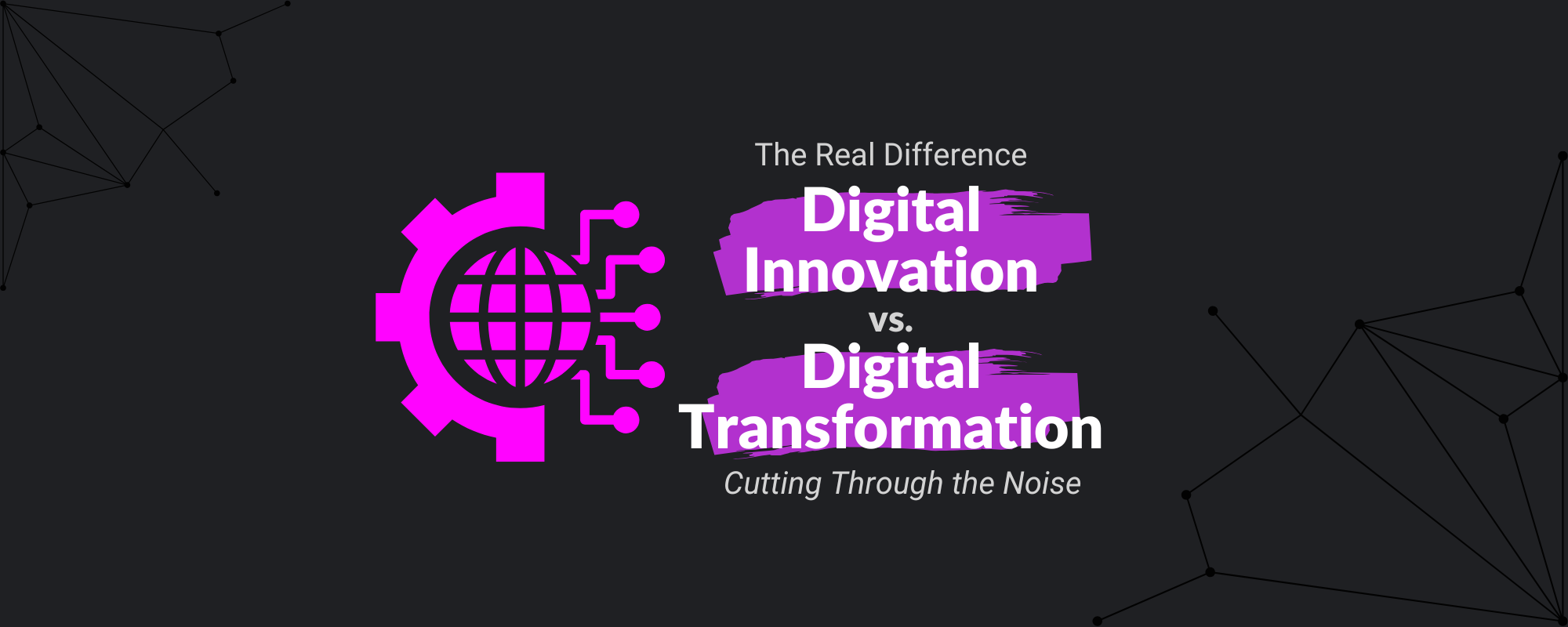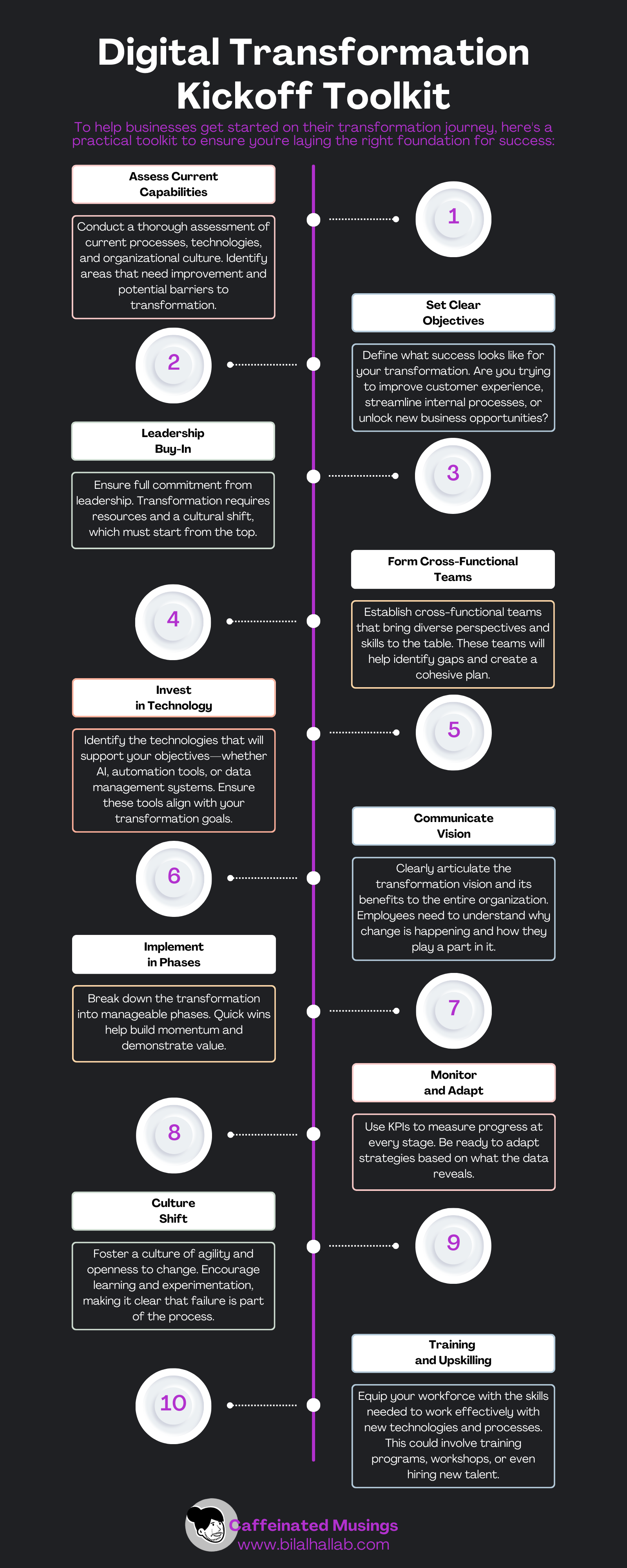The Real Difference Between Digital Innovation and Transformation

You are in a meeting where someone is casually throwing around terms like 'innovation' and 'transformation' as if they mean the same thing. Heads nod, pens scribble, and everyone pretends to know there's a difference. But, what if they really don't? What if, right now, your strategy team is blending these two fundamentally different concepts into a meaningless stew of ambition? The result? A mishmash of initiatives that may look good but don't necessarily drive true progress.
Businesses today often fall into the trap of believing that adding a chatbot or a new app constitutes transformation. Without systemic changes, these innovations are simply superficial improvements that fail to address the real underlying issues. True transformation requires a rethink of core systems, processes, and even culture—it’s the only path to enduring relevance.
Digital innovation and digital transformation are not the same, and conflating them might be the fatal flaw in your long-term plan. This distinction is more than just semantics; it’s the difference between thinking you’re sprinting ahead when, in reality, you're jogging in circles.
Digital innovation is about coming up with new ways to solve problems—it's the fresh tech-driven idea that adds value, like the CRM tool that helps your sales team close deals with precision and efficiency. Digital transformation, however, is the marathon that changes how you run as a company. It's revisiting everything from your customer service protocol to how your supply chain operates and then upgrading it all to compete in a digital world. It's a change of engine, not just a new coat of paint.
And here's the thing: Innovation might get your company a headline or two, but transformation will keep you relevant for decades.
The Definitions We Need to Get Right
To start, let's differentiate between digital innovation and digital transformation. Digital innovation enhances what already exists—it’s like adding a clever new feature to make something better. For example, financial apps that use AI to provide personalized insights are innovation in action. They enhance existing services but don’t fundamentally change how financial institutions operate.
Digital transformation, however, involves overhauling everything. It’s changing how a business functions from the ground up. When Saudi Aramco decided to push for sustainability, they weren’t just adding AI-driven tech to appear modern—they fundamentally rethought their operations.
While innovation is a stepping stone, true transformation propels a company into the future.
The Mindset Shift
To make this discussion more tangible, let me share a personal experience. During my time working with a major financial institution in Saudi Arabia, we faced a pivotal decision: stick to incremental changes or overhaul the entire customer service operation. It wasn't just about adding a chatbot to the customer support—real transformation meant reshaping our entire workflow, altering internal processes, and shifting the team culture toward proactive engagement. This experience taught me that innovation is only valuable if it's matched by the willingness to question and reinvent the fundamentals. And that is what made all the difference.
So why does this matter? Why can't we just continue lumping these concepts together under the broad umbrella of 'digital change'?
Because only one will save your business from becoming irrelevant.
Many companies—both large and small—have innovated but failed to transform. The result is shiny new apps, new customer-facing features, a chatbot here and there, but the same old processes behind the scenes. Innovation is what customers see; transformation is what the organization does, and when these aren’t in sync, the company suffers.
Let's be honest—true transformation is messy. It requires the kind of courage that makes board members shift uncomfortably in their chairs. It means betting on a long-term future instead of a quarterly profit. That’s why most organizations stop at innovation. Transformation means reshaping internal cultures, rethinking processes, and fundamentally changing business models. It’s the hard stuff.
Take Saudi Arabia’s National Transformation Program, for example. The country didn’t just add e-services on top of government bureaucracy; they tore down and rebuilt whole sections of public services from the ground up, changing not only how they interact with citizens but how they perceive the role of government altogether.
And let's not forget: Innovation has visible, instant results, making it easy to sell. Transformation takes time, but when it pays off, it reshapes industries.
The Middle East’s Digital Journey
The healthcare sector provides another interesting example of transformation. Across the Middle East, many hospitals have adopted telehealth services—a classic case of digital innovation. However, some healthcare systems have gone further, fundamentally transforming patient care through integrated AI diagnostics, automated scheduling, and remote monitoring systems. The transformation here isn't just about adding new tools; it's about creating a new model of patient care that allows for early intervention and improved outcomes.
In the Middle East, particularly in the UAE and Saudi Arabia, we've witnessed both innovation and transformation—sometimes coexisting, sometimes at odds. According to the KPMG Tech Survey Saudi Arabia 2023, 80% of organizations in Saudi Arabia claim they're in advanced stages of their digital transformation journeys[1]. But here's the kicker: Innovation without real transformation leaves a beautiful interface covering old habits that drag the entire business down.
Jad Haddad from Oliver Wyman speaks to the heart of UAE’s efforts: “The UAE has always embraced technological advancement and used it for the betterment of the lives of its residents and the enhancement of the economy. AI is no exception; it has been embraced by the UAE at all levels.” To support this commitment, the UAE established several key initiatives, including the appointment of the world's first Minister of State for Artificial Intelligence in 2017, underscoring their dedication to AI development. Additionally, the Mohamed bin Zayed University of Artificial Intelligence (MBZUAI) was founded in 2019 as a research-based academic institution focused on advancing AI, while the Technology Innovation Institute (TII) plays a vital role in applied AI research. These institutions reflect the UAE's proactive approach to integrating AI across various sectors, aiming to enhance both quality of life and economic growth.[2]
Yet, real transformation isn’t just the glitter—it’s the structural commitment to rethink the basics. Saudi Vision 2030 isn’t merely pushing tech innovation; it’s trying to weave technology into the very fabric of how the country’s economy, education, and governance functions.
The UAE, similarly, has leapt head-first into AI. According to a recent survey, 51% of the workforce in the UAE is already interacting with AI in their day-to-day activities[5]. These are big steps forward, but they are also steps that need to be backed by systemic, organization-wide change.
Innovation vs. Transformation in Action
Consider the retail landscape in Saudi Arabia—a sector known for its rapid adoption of digital tools. Many brands in the Kingdom have successfully added online ordering systems, giving customers access at their fingertips. This is digital innovation—a nice layer of convenience on top of a traditional business model. But, when the backend logistics can’t keep up, the shiny front-end features don’t matter much.
Compare that to Amazon. Amazon didn’t just innovate; they transformed. They re-engineered warehouses, delivery processes, and customer service expectations. They transformed themselves internally so the experience externally could feel seamless.
True transformation is about questioning your very purpose. It’s asking, “How should we work if we started from scratch?”
The Numbers Tell a Story
Manufacturing is also embracing transformation. For example, in the UAE, factories are adopting IoT and AI to create smart manufacturing environments. This isn't just about installing new machines—it's about a complete overhaul of how production lines are managed, data is gathered, and efficiencies are optimized. This kind of transformation can reduce waste, improve quality, and create agile responses to market demands.
Only 6% of the Middle Eastern public lives under a truly digitized smart government[3]. That’s a small number, especially when contrasted with the promise of tech that governments and industries keep touting.
A unified digital market across the Middle East, with a projected 160 million potential users by 2025, could add $95 billion to GDP annually[3]. It sounds fantastic on paper, but it won’t be the result of innovation alone. For that kind of market-wide value, we need transformation—a fundamental change in how digital markets are approached, how governments think, how data is shared across borders.
Mindsets Companies Need
To innovate successfully, you need a creative, experimental mindset. Think of it as a playground—try something new, and if it doesn't work, you move on to the next. It’s agile, it’s fun, it’s small scale. Transformation, though, requires courage. It demands structural rethinking. It's about building that engine, brick by brick, knowing that it may take years before it shows the value you're seeking.
Ahmed Mohammed Al-Suwaiyan, governor of the Digital Government Authority in Saudi Arabia, encapsulates the essence of transformation: “The Digital Transformation Index serves as a crucial technological empowerment tool for the transformation journey. It reinforces the strategic objectives of e-governance in the Kingdom, aligning seamlessly with the targets outlined in Vision 2030, which aims for Saudi Arabia to emerge as a premier global leader in digital administration.”[4]
Takeaways for Businesses
Let me share a brief story from a client I worked with in the retail industry, the brand is part of a family-named holding group whom as of January 2024 had a total of 71 stores (20 stores in the UAE and 51 stores in KSA) for that specific brand alone. They were determined to launch a flashy e-commerce platform to keep up with their competitors, but their internal logistics couldn’t support the customer demand. We shifted the focus from the shiny front-end to revamping their entire supply chain process, introducing automation and streamlining inventory management. The result? Not only did customer satisfaction improve, but the company also saw a 30% reduction in operational costs within a year. This kind of fundamental transformation is what truly makes an impact.
So what should companies in the region do? The path forward requires a blend of both innovation and transformation.
For innovation, create pockets of experimentation—innovation labs, agile teams, and small projects that can be implemented quickly. Let them fail fast and learn fast. Adopt an innovation mindset that’s more about immediate results, finding new ways to add value and engage customers.
For transformation, push for systemic change. It must come from the top. CEOs and boards need to buy into it fully, not just as a slogan. Transform how decisions are made, how teams collaborate, how processes flow. It’s about cultural readiness as much as it is about technology.
Think of digital innovation as the colorful paint job on a car. It’s appealing, eye-catching, and makes a statement. Digital transformation, however, is the overhaul of that car’s engine—the upgrade that makes the car more powerful, more resilient, capable of going the distance.
The Reality Check
True transformation is difficult, even painful. It’s not something you can run on a pilot project and claim victory. It’s hard because it challenges the status quo, because it forces people to rethink the way they’ve been working, sometimes for decades.
But here’s the truth: Without transformation, innovation will eventually run out of steam. A company that doesn’t transform is like a house of cards built on shaky foundations. One strong gust, and it could all come down.
Businesses need to stop treating digital transformation as a box to tick and start treating it as an evolving strategy, a continuous reimagining of their existence.
The companies that thrive over the next decade will be those that dare to go beyond the flashy gadgets and dive deep into redefining themselves at their very core. Not just those willing to paint the car a new color, but those willing to rebuild the entire engine.
What will you do today to start rebuilding your engine? Are you ready to make the tough choices that lead to lasting transformation?
Here is a kickoff toolkit I created to help you get started on your digital transformation journey, ensuring that you have a solid foundation to build upon for real, lasting change:

Transformation isn’t a one-size-fits-all journey. It’s about tailoring the process to your organization’s needs while ensuring a focus on systemic, cultural, and technological change.
[1] KPMG Tech Survey Saudi Arabia 2023. KPMG.
[2] Economic Times, "Artificial Intelligence Ignites Dubai's Transformation - A Hub for Innovation and Smart Cities". Economic Times.
[3] McKinsey, "Digital Middle East: Transforming the Region into a Leading Digital Economy". McKinsey.
[4] Arab News, "National Transformation and Digital Leadership in Saudi Arabia". Arab News.
[5] PwC Middle East Workforce Hopes and Fears Survey 2024. PwC.



Discussion